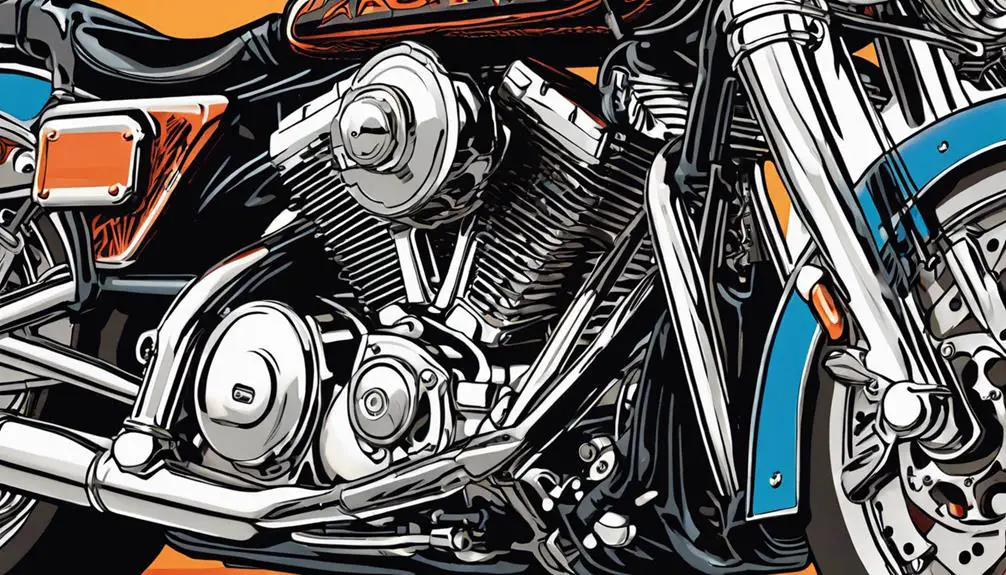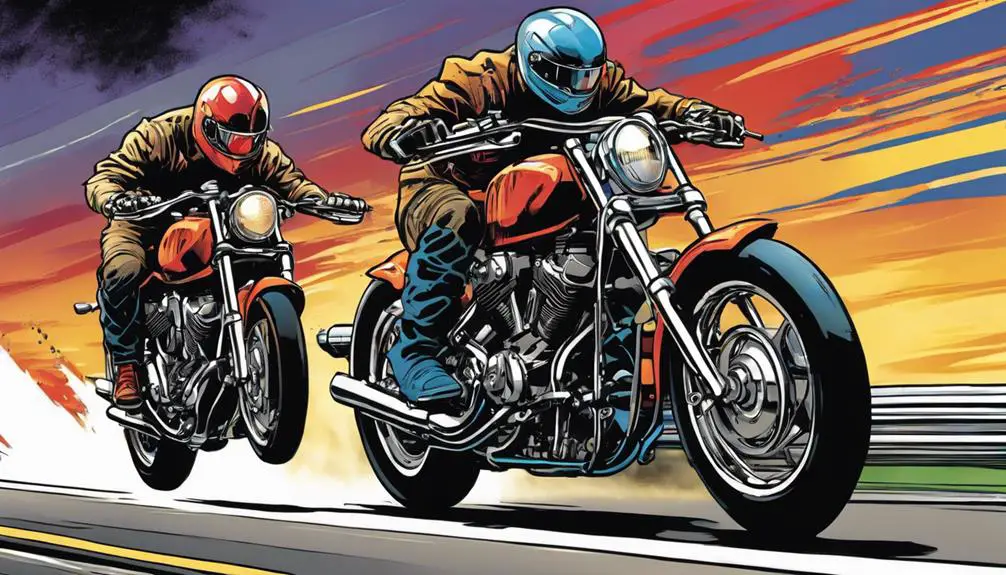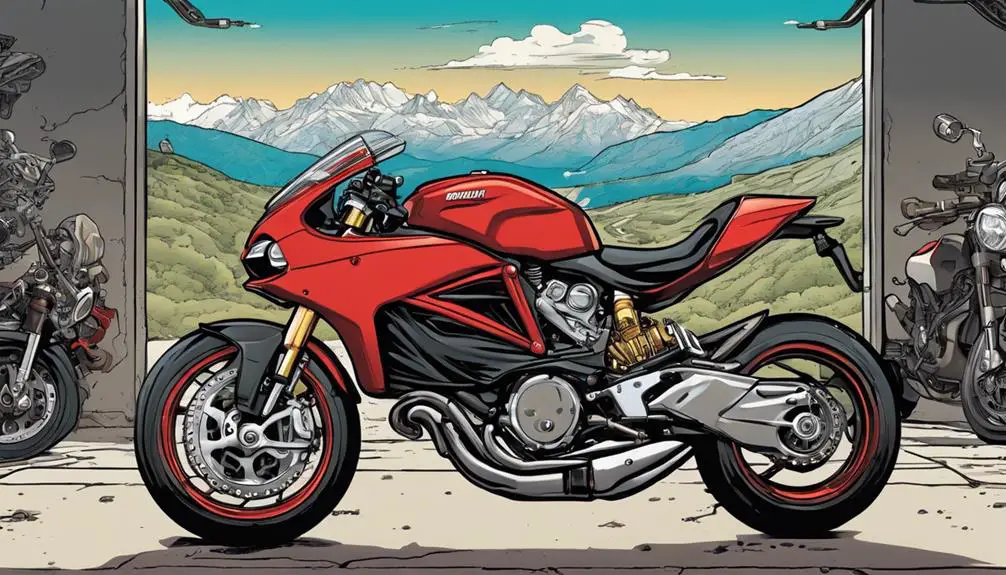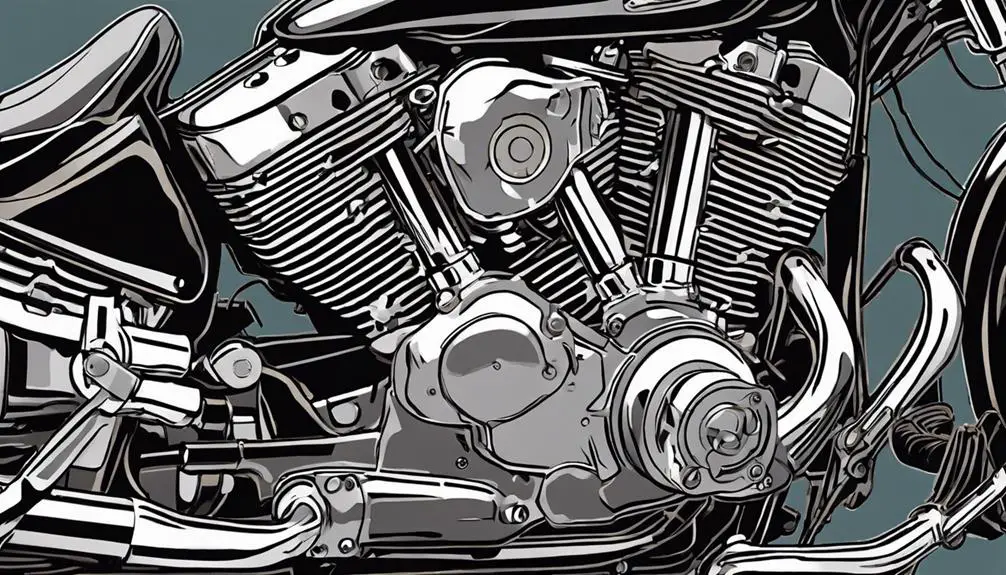You might think all motorcycle engines deliver similar performance, but V-Twin engines stand out with their unique advantages. Their low to mid-range power delivery makes them particularly suited for urban and spirited riding, which many riders appreciate. The distinctive V configuration not only enhances torque but also improves throttle response, leading to a more engaging ride. However, the performance nuances can vary considerably between manufacturers, especially when you consider innovations like Ducati's Desmodromic valve system. So, what sets Ducati apart in this competitive landscape?
Key Takeaways
- V-Twin engines excel in low to mid-range power, making them ideal for urban riding and quick throttle response.
- Ducati's L-twin configuration enhances torque delivery, contributing to robust acceleration and engaging riding experiences.
- Fuel efficiency is improved through high compression ratios, electronic fuel injection, and aerodynamic designs, positioning Ducati models favorably against rivals.
- Weight distribution and responsive suspension systems enhance agility and stability, improving ride quality and comfort during various riding conditions.
Overview of V-Twin Engines

V-twin engines, known for their distinctive design and powerful performance, offer a unique blend of torque and sound that riders often crave. When you twist the throttle, you feel the immediate response, a surge of energy that propels you forward with exhilarating force. The engine's layout, featuring two cylinders in a V formation, contributes to its character, creating a throaty growl that resonates with your adventurous spirit.
These engines typically excel in low to mid-range power, making them ideal for urban riding and spirited backroad jaunts. You'll appreciate the way they deliver torque, providing that satisfying pull when you need to accelerate quickly. With a V-twin, your ride becomes more than just transportation; it's an experience that ignites your passion for freedom.
Many riders find that the V-twin's simplicity also aids in maintenance, allowing you to spend more time on the road and less time in the garage. Whether you're cruising the highway or maneuvering twisty roads, the V-twin engine promises a liberating experience that resonates deep within you, inviting you to embrace every moment spent in the saddle.
Ducati's V-Twin Engine History
Ducati's journey with V-twin engines began in the mid-20th century, setting the stage for a legacy of performance and innovation.
You'll discover that Ducati introduced its first V-twin engine in 1971, the 750 GT, which combined style with power, revolutionizing the motorcycle landscape. This engine marked a pivotal moment, showcasing Ducati's commitment to pushing boundaries and embracing the thrill of freedom on two wheels.
Throughout the years, Ducati refined its V-twin designs, leading to the iconic L-twin configuration. This engine layout not only enhanced torque delivery but also offered a distinct sound that motorcycle enthusiasts crave. You can feel the spirit of liberation as you twist the throttle, experiencing the raw power and precision that Ducati engines provide.
As you explore Ducati's history, you'll see how these engines have been integral in shaping Ducati's identity in motorsport, winning numerous championships and solidifying Ducati's status as a performance leader.
With every model, Ducati has blurred the lines between engineering and art, inviting you to join a community that celebrates passion, innovation, and the exhilarating ride of a lifetime.
Performance Characteristics

When comparing V-twin engines, you'll notice distinct performance characteristics that set them apart, especially regarding torque delivery and responsiveness.
These engines are known for their robust low-end power, giving you that exhilarating feeling of acceleration right when you twist the throttle. You'll appreciate how quickly they respond to your commands, allowing for smooth, immediate power transfer. This characteristic makes V-twins perfect for spirited rides through winding roads or urban environments.
Moreover, the unique design of V-twin engines provides a thrilling engine note that resonates with the freedom you crave. Feel the vibrations through the frame, connecting you with the machine in a way that makes every ride feel alive.
You'll find that these engines often excel in providing a sense of stability and control, especially at lower speeds. The punchy performance allows you to take on challenging terrains with confidence, and it invites you to embrace the open road.
Whether you're cruising or carving through corners, the engaging characteristics of V-twin engines enhance your riding experience, giving you the freedom to express your adventurous spirit.
Torque and Horsepower Comparisons
The impressive low-end torque of V-twin engines often leads to exciting horsepower comparisons that highlight their performance capabilities. When you twist the throttle, you'll feel that rush of power, and it's this combination of torque and horsepower that makes these bikes thrilling to ride. V-twins typically excel in delivering strong torque at lower RPMs, allowing for quick acceleration and a more engaging riding experience.
Here are some key factors that help you understand torque and horsepower in V-twin engines:
- Torque Measurement: Torque is essential for initial acceleration and pulling power.
- RPM Influence: Horsepower peaks at higher RPMs, making it vital for top speeds.
- Power Band: The engine's power band affects how you experience acceleration.
- Engine Design: Different configurations (e.g., 45-degree or 60-degree) impact torque delivery.
Ultimately, the blend of torque and horsepower in V-twin engines creates a unique riding experience, giving you the freedom to release your spirit on the road. Embrace that power, and enjoy the ride!
Fuel Efficiency in Ducati Models

When you think about fuel efficiency in Ducati models, you'll notice how engine design plays an essential role.
Riding conditions can greatly affect how far you can go on a tank of gas, too.
Plus, comparing Ducati's fuel efficiency to its rivals reveals some interesting insights worth considering.
Engine Design Impact
Ducati's innovative engine designs greatly enhance fuel efficiency, allowing riders to enjoy longer journeys without frequent stops. By focusing on lightweight materials and advanced engineering, Ducati creates motorcycles that not only deliver thrilling performance but also maximize fuel economy. You'll feel the liberation of the open road, knowing your bike is working effectively.
Here are some key features contributing to Ducati's fuel efficiency:
- Desmodromic Valves: These reduce engine strain, enhancing combustion efficiency.
- High Compression Ratios: They improve power output, reducing fuel consumption.
- Electronic Fuel Injection: This technology fine-tunes fuel delivery for peak performance.
- Lightweight Components: Less weight means less energy needed to maintain speed.
With these cutting-edge elements, Ducati empowers you to ride further and explore the world without the anxiety of frequent refueling. Each ride becomes a liberating experience, unburdened by the constraints of traditional fuel economy. Embrace the freedom of the open road, and let Ducati's engine designs fuel your adventures.
Riding Conditions Influence
Riding conditions can markedly affect the fuel efficiency of Ducati models, as factors like terrain, weather, and riding style play a significant role in how well the engine performs.
When you hit the open road, the type of terrain can either free or restrict your fuel consumption. Maneuvering twisty mountain roads may lead to more aggressive acceleration and deceleration, reducing efficiency compared to cruising on smooth highways.
Weather conditions also matter. Riding in heavy rain or strong winds can create drag, forcing your engine to work harder and sip more fuel. Conversely, a sunny day with mild temperatures often lets you ride more efficiently, maximizing your Ducati's performance.
Your riding style is equally important. Smooth, gradual throttle inputs tend to yield better fuel efficiency. If you're the type who loves to twist the throttle hard, you might find your fuel gauge dropping faster than you'd like.
Comparison to Rivals
Fuel efficiency in Ducati models often stands out when compared to rivals, showcasing a blend of performance and economy that appeals to riders. When you hit the road on a Ducati, you're not just enjoying the roar of the engine; you're also benefiting from technology designed to maximize every drop of fuel. This efficiency lets you liberate yourself from frequent stops at the pump, giving you more time to savor the ride.
Here are some key points that highlight Ducati's fuel efficiency:
- Advanced Engine Technology: Ducati utilizes sophisticated engineering to enhance combustion efficiency.
- Lightweight Design: The slim frame and materials reduce weight, contributing to better fuel consumption.
- Enhanced Aerodynamics: Streamlined body shapes reduce drag, allowing for higher speeds with less effort.
- Rider Modes: Flexible riding modes let you adjust performance versus efficiency based on your needs.
With these features, Ducati models offer a compelling choice for those who crave freedom on two wheels without sacrificing efficiency.
Handling and Ride Quality
When you ride a V-Twin motorcycle, the weight distribution plays an essential role in how it handles on the road. A well-balanced bike can enhance your confidence in corners, while a poorly balanced one might leave you feeling unstable.
Additionally, the suspension system's design directly influences ride quality, affecting everything from comfort to responsiveness.
Weight Distribution Effects
Proper weight distribution in a V-twin engine greatly enhances handling and ride quality, making your experience on the road smoother and more responsive.
When the weight is balanced, you'll notice improved cornering stability and a more confident ride, allowing you to feel more in control of your motorcycle.
Here are some key benefits of proper weight distribution:
- Increased agility: A balanced bike reacts quicker to your inputs, making it easier to navigate tight turns.
- Enhanced stability: Weight evenly spread across the chassis helps maintain traction, especially during high-speed maneuvers.
- Better braking performance: Proper distribution allows for smoother, more effective braking, reducing the chance of skidding or losing control.
- Improved comfort: A well-balanced motorcycle minimizes fatigue, letting you enjoy longer rides without discomfort.
Embracing these elements of weight distribution can liberate your riding experience, allowing you to connect more deeply with your motorcycle and the open road ahead.
Suspension System Impact
A well-tuned suspension system directly affects your motorcycle's handling and ride quality, complementing the benefits of balanced weight distribution for an overall enhanced riding experience.
When you hit the road, a responsive suspension absorbs bumps and imperfections, allowing you to glide smoothly, feel liberated, and connect with the ride.
Adjustable components like forks and shocks let you fine-tune your setup based on riding style and terrain. If you're tackling twisty roads, a stiffer suspension improves cornering stability, giving you confidence to lean into those curves. On the other hand, if you're cruising down long highways, a softer setting can provide comfort, reducing fatigue.
You'll notice that a well-designed suspension not only enhances handling but also improves traction. This means better grip on various surfaces, allowing you to ride with freedom and control.
The relationship between your motorcycle's weight distribution and suspension setup creates a harmonious balance, encouraging you to push the limits and explore new horizons.
Ultimately, investing time in understanding your suspension can transform your riding experience, granting you the liberation and thrill you crave.
Common Engine Issues

Encountering common engine issues can greatly impact the performance and reliability of your V-Twin engine. You want your ride to be liberating, not a hassle, so it's essential to recognize and address these potential problems early on.
Here's a rundown of some frequent engine issues you might face:
- Oil Leaks: These can lead to inadequate lubrication, increasing wear and tear on your engine.
- Overheating: This issue can stem from poor coolant circulation, risking engine damage if not fixed.
- Ignition Problems: Faulty spark plugs or ignition coils can affect starting and overall performance.
- Fuel System Clogs: Dirty fuel injectors or carburetors can restrict fuel flow, leading to sluggish acceleration.
Innovations in Ducati V-Twins
Ducati's relentless pursuit of performance and technology has led to groundbreaking innovations in their V-Twin engines, making them a favorite among motorcycle enthusiasts. When you hop on a Ducati, you experience not just power but a symphony of engineering marvels designed to liberate your ride.
One of the most significant advancements is the Testastretta engine, which offers increased torque and responsiveness. You'll feel the difference as the engine revs freely, delivering exhilarating acceleration.
Ducati also introduced the Desmodromic valve system, allowing for precise control over valve timing, which enhances both performance and efficiency.
Incorporating electronic systems like the Ducati Performance Traction Control and Riding Modes lets you customize your ride to match your spirit. Whether you crave a thrilling track day or a smooth cruise, these features adapt to your desires.
Ducati's innovative use of lightweight materials, like their trellis frames, not only enhances performance but also contributes to the agility you crave.
With each innovation, Ducati empowers you to embrace the open road, celebrating the freedom and thrill of the ride. It's not just a motorcycle; it's a liberation machine.
Frequently Asked Questions
How Does a V-Twin Compare to Other Engine Types?
When you think about engine types, a V-twin stands out for its unique design and performance characteristics.
It typically offers a strong low-end torque, giving you that satisfying power right off the line.
Compared to inline engines, V-twins can feel more responsive and offer a distinctive rumble that many riders love.
Other types, like flat or rotary engines, may excel in efficiency or smoothness, but the V-twin's raw power and character can't be easily matched.
What Is the Lifespan of a Typical V-Twin Engine?
When you think about a V-Twin engine's lifespan, consider it a journey rather than a destination.
Typically, these engines can last anywhere from 30,000 to over 100,000 miles, depending on how you treat them.
Regular maintenance and care can help you access their full potential.
Are V-Twin Engines More Expensive to Maintain?
Yes, V-twin engines can be more expensive to maintain. Their unique design often requires specialized parts and skilled mechanics, which can drive up costs.
You might find that routine maintenance, like oil changes and valve adjustments, takes more time and resources compared to other engine types.
However, the distinct sound and performance may be worth it for you, as they often provide a thrilling ride that few others can match.
Can V-Twin Engines Be Modified for Better Performance?
If you're looking to release the beast within, you can definitely modify V-Twin engines for better performance.
With a few tweaks, like upgrading the exhaust, tuning the fuel system, or adding a performance cam, you'll feel the difference.
Just remember, each modification can affect reliability, so it's a balancing act.
Immerse yourself in aftermarket parts and don't shy away from expert advice to maximize your ride's potential and truly feel the freedom on the road.
What Bikes Use V-Twin Engines Besides Ducati?
If you're exploring bikes with V-twin engines beyond Ducati, you'll find a variety of options.
Harley-Davidson is a classic choice, offering models like the Sportster and Softail.
Indian Motorcycle also features V-twins in their Scout and Chief models.
Don't forget about the Aprilias, like the Tuono and RSV4, which pack a punch.
Each bike brings its own flavor of freedom, so take your time and discover which one speaks to you!
Conclusion
In the world of motorcycles, V-Twin engines stand as modern-day chariots, blending power and finesse.
You can feel the raw torque and responsive throttle that make each ride an adventure, echoing the thrills of ancient warriors.
Ducati's innovations elevate this experience, marrying performance with efficiency.
As you twist the throttle, remember that you're not just riding a bike; you're harnessing a legacy of engineering that carries the spirit of speed and freedom forward.